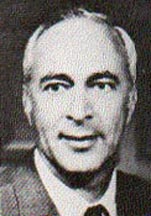
Albert Bandura:
Albert Bandura came up with the theory called "Social Cognitive Theory". It focused on the learning that occurs within a social context. It also takes into consideration the fact that people learn from one another, including observational learning, imitation, and modeling. He stated that people can learn by observing the behavior is of others and the outcomes of those behaviors,l learning can occur without a change in behavior, also cognition plays a role in this theory, since social learning theory has become increasingly cognitive in its interpretation of human learning. He also believed that the environment reinforces and punishes modeling The Social learning theory can be considered a bridge or a transition between behaviorist learning theories and cognitive learning theories.

Julian Rotter:
Julian Rotter came up with the theory called "Social Learning Theory". This Theory is derived from the work of Albert Bandura.It stated that the environment is defined as the external stimuli that the individual recognizes and responds to. The theory was based upon five main concepts. The first of these concepts is reinforcement, describes anything that has an influencing effect on occurrence, a type of behavior, or direction. The next concept is reinforcement value, which is the amount of preference that one has for any reinforcement to exist if the various reinforcements were equal.The next concept is psychological situation which is characterized in regards to a person, this allows an individual to categorize based on other specific situations, and also allows a person to differentiate it from others as well.The next concept is expectancy, refers to the probability that an individual has that a specific reinforcement will exist as a certain function of a particular behavior on the individual's part within a certain or various situations. The last of Julian Rotter's major concepts is generalized expectancy, its expectancy that counts for numerous and various situations that are comparable to each other to a certain degree.

Martin Seligman:
Martin Seligman came up with the theory of "Learned Helplessness". Learned Helplessness is seen as a coping mechanism some people employ in order to survive difficult or abusive circumstances. This has also been associated with several different psychological disorders. Depression, anxiety, phobias, shyness and loneliness can all be exacerbated by learned helplessness. Martin came up with this theory by conducting a very cruel experiment on dogs, which included ringing a bell while shocking a restrained dog. He then allowed it to move out of the way and rang the bell again. The dog did not move since it had learned was not that ringing a bell means pain, but that it is useless trying to get away from shocks. He believed that how we attribute the events that occur in our lives has a significant effect on our attitudes and efforts in improving our lot.

Aaron Beck:
Aaron Beck came up with the theory of "Cognitive Behavior". He believed that that one's thoughts and beliefs affect one’s behavior and subsequent actions, that dysfunctional behavior is caused due to dysfunctional thinking, and that thinking is shaped by our beliefs. Our beliefs decide the course of our action. Theorists suggest that depression results from faulty and irrational psychological perception, which cause distorted learning and reasoning. Depression could be a result of a traumatic experience or incapability of adaptive coping skills. Depressive people have a negative perception or belief about themselves and their environment. The more someone has negative thoughts more is the severity of one's depression symptoms.


